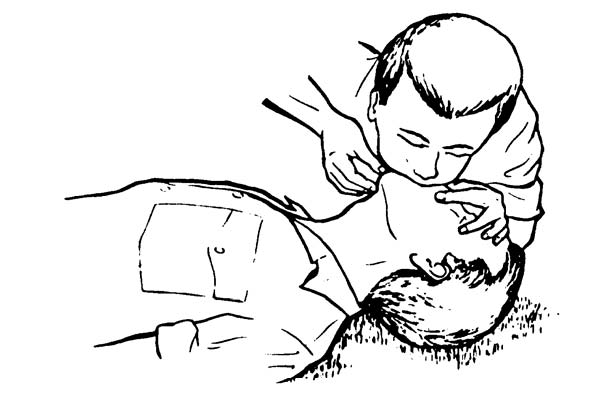BURNS AND SCALDS
Burns are caused by dry heat, corrosive substances and friction. Scalds are caused by wet heat – hot liquids and vapours. Burns can also be produced by extreme cold, and by radiation, including the sun’s rays. Burns may be related to, or a result of, a more life-threatening situation. Fires may be started accidentally by victims of drug or alcohol overdose. An explosion, or jumping from a burning building, may cause other serious injuries. When burns have been treated, the casualty should be thoroughly examined.
Assessing a Burn
There are a number of factors to consider when assessing the severity of a burn and the method of treatment, including the cause of the burn, whether the airway is involved, the depth of the burn, and its extent.
The extent of the burn will indicate whether shock is likely to develop, as tissue fluid (serum) leaks from the burned area and is replenished by fluids from the circulatory system. The greater the extent of the burn, the more severe the shock will be. The cause of the burn may also signal any other possible complications. Burns also carry a serious risk of infection, which increases according to the size and depth of the burn. The body’s natural barrier, the skin, is destroyed by burning, leaving it exposed to germs.
Depth of Burns
Burns can be categorised as follows:
|
Body Parts​ |
Percentage |
|
Head |
09% |
|
Neck |
01% |
|
One Hand |
09% |
|
Body Front |
18% |
|
Body Back |
18% |
Superficial burns
These involve only the outer layer of the skin, and are characterised by redness, swelling and tenderness. Typical examples are mild sunburn, or a scald produced by a splash of hot tea or coffee. Superficial burns usually heal well if prompt first aid is given, and do not require medical treatment unless extensive.
Partial-thickness Burns
These damage a ‘partial thickness’ of the skin, and require medical treatment. The skin looks raw, and blisters form. These burns usually heal well, but can be serious, if extensive. In adults, partial-thickness burns affecting more than 50% of the body’s surface can be fatal. This percentage is less in children and the elderly.
Full-thickness Burns
These damage all layers of the skin. Damage may extend beyond the skin to affect nerves, muscle and fat. The skin may look pale, waxy, and sometimes charred. Full-thickness burns of any size always require immediate medical attention, and usually require specialist treatment.
Extent of Burns
The area of a burn gives an approximate indication of the degree of shock that will develop and, in conjunction with depth, can be used as a guide to the required level of treatment. The ‘rules of nine’ is a guide used to calculate the extent of a burn as a percentage of the body’s total surface area, and to assess what level of medical attention is required.
In an otherwise healthy adult:
- Any partial-thickness burn of 1% or more (an area approximating to that of the casualty’s hand) must be seen by a medical practitioner.
- A partial-thickness burn of 9% or more will cause shock to develop, and the casualty will require hospital treatment.
- A full-thickness burn of any size requires hospital treatment.
Severe Burns and Scalds
The priority is to cool the injury; the longer the burning goes unchecked, the more severely the casualty will be injured. Resuscitate the casualty only when cooling is underway. All severe burns carry the danger of shock.
Treatment of Severe Burns and Scalds
DO NOT overcool the casualty; this may dangerously lower the body temperature.
DO NOT remove anything sticking to the burn; this may cause further damage and cause infection.
DO NOT touch or interfere with the injured area.
DO NOT burst blisters.
DO NOT apply lotions, ointment, or fat to the injury.
- Lay the casualty down, protecting the burned area from contact with the ground, if possible.
- Douse the burn with copious amounts of cold liquid. Thorough cooling may take 10 minutes or more, but this must not delay the casualty’s transmission to hospital.
- While cooling the burns, check airway, breathing, and pulse, and be prepared to resuscitate.
- Gently remove any rings, watches, belts, shoes, or smouldering clothing from the injured area, before it starts to swell. Carefully remove burned clothing unless it is sticking to the burn.
- Cover the injury with a sterile burns sheet or other suitable non-fluffy material, to protect from infection. A clean plastic bag or kitchen film may be used. Burns to the face should be cooled with water, not covered.
- Ensure that the emergency service is on its way. While waiting, treat the casualty for shock. Monitor and record breathing and pulse, and resuscitate, if necessary.
Burns to the Mouth and Throat
Burns to the face, and burns in the mouth or throat are very dangerous, as they cause rapid swelling and inflammation of the air passages. The swelling will rapidly block the airway, giving rise to a serious risk of suffocation. Immediate and highly specialised medical assistance is required.
Treatment of Burns to the Mouth and Throat
- Contact the emergency service. Report suspected burns to the airway.
- Take any steps to improve the casualty’s air supply, e.g., loosening clothing around the neck. Give the casualty oxygen if you are trained to do so.
- If the casualty becomes unconscious, place in the recovery position, and be prepared to resuscitate.
Minor Burns and Scalds
Minor burns and scalds are usually the result of domestic accidents. Prompt first aid will generally enable them to heal naturally and well, but the advice of a medical practitioner should be sought if there is doubt as to the severity of the injury.
Treatment of Minor Burns and Scalds
DO NOT use adhesive dressings.
DO NOT break blisters, or interfere with the injured area.
DO NOT apply lotions, ointments, creams, or fats to the injured area.
- Cool the injured part with copious amounts of cold water for about 10 minutes to stop the burning and relieve the pain. If water is unavailable, any cold, harmless liquid such as milk or canned drinks will suffice.
- Gently remove any jewellery, watches, or constricting clothing from the injured area before it starts to swell.
- Cover the injury with a sterile dressing, or any clean, non-fluffy material to protect from infection. A clean plastic bag or kitchen film may be used




